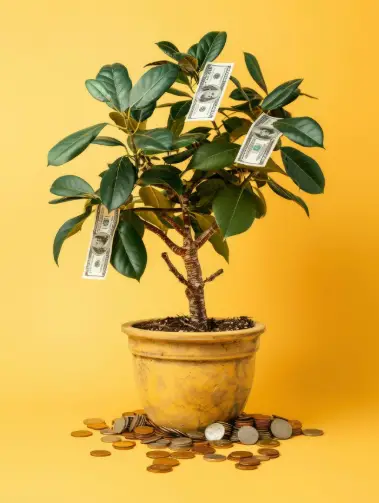The Money Tree Plant: Ancient Wisdom Meets Modern Home Wellness
Discover the fascinating dual nature of one of the world’s most popular houseplants
Beyond Decoration: The Hidden World of Money Tree Plants
In homes across America, millions of people cultivate what they believe is simply an attractive houseplant that brings good fortune. The money tree, scientifically known as Crassula ovata or jade plant, has become a staple in modern interior design and feng shui practice. However, beneath its glossy green leaves lies a remarkable story of traditional medicine, natural healing properties, and an ancient connection between plants and human wellness that most homeowners never discover.
This comprehensive guide explores the lesser-known aspects of money tree cultivation, revealing why this humble succulent has captured the attention of both spiritual practitioners and natural health enthusiasts for centuries.
The Spiritual and Energetic Connection
Feng Shui Foundations and Prosperity Symbolism
According to traditional feng shui principles, the money tree serves as more than decorative greenery—it functions as a living symbol of financial abundance and positive energy flow. Practitioners believe that proper placement of this plant can enhance wealth accumulation, career advancement, and overall prosperity within the household.
The plant’s thick, coin-shaped leaves are thought to represent monetary abundance, while its sturdy trunk symbolizes financial stability and growth. Traditional placement guidelines suggest positioning money trees in the southeast corner of living spaces, known as the “wealth corner” in feng shui practice.
The Health Indicator Phenomenon
Perhaps the most intriguing aspect of money tree lore involves its alleged ability to reflect the health status of household members. According to traditional beliefs, these plants serve as living barometers of human wellness, exhibiting visible changes that correspond to the physical condition of their caretakers.
Practitioners report that money trees may begin showing signs of stress—yellowing leaves, wilting, or general decline—when household members experience illness or emotional distress. Conversely, as human health improves, the plant reportedly demonstrates renewed vitality, developing fresh growth and regaining its characteristic lustrous appearance.
While scientific evidence for this phenomenon remains limited, the observed correlation has fascinated plant enthusiasts and alternative health practitioners for generations, suggesting a deeper connection between human wellness and plant vitality than conventional science typically acknowledges.
Scientific Understanding of Medicinal Properties
Traditional Medicine Applications
The medicinal use of Crassula ovata extends back centuries in traditional healing systems, particularly in African and Asian cultures where the plant grows naturally. Modern phytochemical analysis has identified several bioactive compounds that may explain the plant’s traditional therapeutic applications.
Anti-inflammatory Compounds: Research has identified flavonoids and other polyphenolic compounds in money tree leaves that demonstrate anti-inflammatory properties in laboratory studies. These compounds may help reduce localized inflammation when applied topically.
Antimicrobial Activity: Studies suggest that extracts from jade plant leaves exhibit bactericidal and antiviral properties against certain microorganisms, supporting traditional uses for wound care and skin conditions.
Antioxidant Properties: The high concentration of flavonoids in money tree leaves provides significant antioxidant activity, potentially protecting skin cells from oxidative damage when used in topical applications.
Comparison to Established Medicinal Plants
In terms of therapeutic potential, traditional medicine practitioners often compare the money tree to aloe vera, another succulent plant renowned for its healing properties. Both plants share similar mechanisms of action, including anti-inflammatory effects and wound-healing promotion, though their specific chemical compositions differ significantly.
Unlike aloe vera, which has undergone extensive clinical research, scientific studies on Crassula ovata remain limited, emphasizing the importance of cautious use and proper understanding of potential risks and benefits.
Practical Applications for Home Wellness
Important Safety Considerations
Before exploring specific applications, it’s crucial to understand the safety profile of money tree preparations. The plant has demonstrated an ability to accumulate trace amounts of arsenic from soil, though this characteristic is significantly reduced in houseplants compared to wild specimens growing in metal-rich soils.
External Use Only: All money tree applications should be limited to external use. Internal consumption is not recommended due to potential toxicity concerns and lack of safety data.
Patch Testing: Before using money tree preparations on large areas, conduct a small patch test to check for allergic reactions or skin sensitivity.
Quality Control: Use only healthy, well-maintained houseplants that have been grown in quality potting soil free from contamination.
Skin Care and Minor Wound Treatment
Callus and Corn Management
Traditional applications include using fresh money tree leaves for softening and reducing calluses and corns on feet and hands. The process involves:
- Preparation: Select a healthy, mature leaf from the plant
- Processing: Remove the thin outer membrane from the leaf surface
- Application: Place the exposed leaf flesh against the affected area
- Securing: Use medical tape or bandages to hold the leaf in place overnight
- Removal: Gently remove in the morning and assess results
Minor Burn Care
For superficial burns without blistering, money tree leaves may provide cooling relief and promote healing:
- Apply only to minor, first-degree burns
- Ensure the burned area is clean before application
- Monitor for signs of infection or delayed healing
- Seek professional medical care for serious burns
Cuts, Scrapes, and Abrasions
Creating a paste from money tree leaves may help with minor wound care:
- Preparation: Crush clean, healthy leaves into a smooth paste
- Application: Apply a thin layer to the cleaned wound
- Covering: Secure with sterile bandaging
- Maintenance: Replace every 2-3 hours with fresh paste
- Monitoring: Watch for signs of healing or complications
Skin Condition Management
Cold Sore Treatment
The antiviral properties of money tree juice may help with cold sore management:
- Extract juice from freshly crushed leaves
- Apply directly to affected areas using a clean cotton swab
- Reapply several times daily during active outbreaks
- Discontinue use if irritation develops
Insect Bite Relief
For reducing inflammation and discomfort from insect bites:
- Apply fresh juice directly to bite locations
- Reapply every 2-3 hours as needed
- Effective for mosquito bites, bee stings, and similar reactions
- Monitor for allergic reactions to the plant material
Acne and Skin Blemish Care
The anti-inflammatory and antimicrobial properties may benefit acne-prone skin:
- Use fresh juice as a spot treatment for individual blemishes
- Apply before bedtime for overnight treatment
- Start with small test areas to assess skin tolerance
- Combine with proper skincare routine for best results
Professional Recommendations and Contraindications
Who Should Avoid Money Tree Applications
Certain populations should exercise extra caution or avoid using money tree preparations entirely:
Pregnant and Breastfeeding Women: Due to limited safety data and potential for systemic absorption, pregnant and nursing mothers should avoid topical money tree applications.
Children Under 12: Young children’s sensitive skin and potential for accidental ingestion make money tree use inadvisable in this population.
Individuals with Sensitive Skin: Those with known plant allergies or sensitive skin conditions should conduct thorough patch testing before use.
People with Compromised Immune Systems: Individuals with weakened immune systems should consult healthcare providers before using any botanical preparations.
Integration with Modern Healthcare
While traditional applications of money tree preparations may offer benefits for minor skin conditions, they should complement, not replace, conventional medical treatment. For serious health concerns, cuts requiring stitches, infected wounds, or persistent skin conditions, professional medical evaluation remains essential.
Cultivation Tips for Therapeutic Quality
Optimal Growing Conditions
To maximize the therapeutic potential of your money tree:
Light Requirements: Provide bright, indirect sunlight for healthy leaf development Watering Protocol: Allow soil to dry between waterings to prevent root rot Soil Selection: Use well-draining succulent soil mix free from heavy metals Temperature Control: Maintain temperatures between 65-75°F for optimal growth Fertilization: Use balanced, diluted fertilizer during growing season
Harvesting and Preparation Guidelines
Timing: Harvest leaves during active growing seasons for maximum potency Selection: Choose healthy, mature leaves without damage or discoloration Cleaning: Thoroughly wash leaves before use to remove dust and potential contaminants Storage: Use fresh preparations immediately; avoid storing plant material
The Future of Plant-Based Home Wellness
As interest in natural health solutions continues growing, plants like the money tree represent fascinating intersections between traditional wisdom and modern wellness practices. While scientific research on Crassula ovata remains limited compared to other medicinal plants, the centuries of traditional use suggest potential applications worthy of further investigation.
The key to safely incorporating money tree preparations into home wellness routines lies in understanding both the potential benefits and limitations, using appropriate caution, and maintaining realistic expectations about what these natural remedies can accomplish.
Whether viewed through the lens of feng shui energy work, traditional medicine, or modern botanical science, the money tree continues to offer homeowners opportunities to explore the fascinating world of plant-human interaction while potentially supporting minor health and wellness goals.
Remember: when it comes to natural health applications, knowledge, caution, and professional guidance remain your most valuable tools for safe and effective use.

Adrian Hawthorne is a celebrated author and dedicated archivist who finds inspiration in the hidden stories of the past. Educated at Oxford, he now works at the National Archives, where preserving history fuels his evocative writing. Balancing archival precision with creative storytelling, Adrian founded the Hawthorne Institute of Literary Arts to mentor emerging writers and honor the timeless art of narrative.
